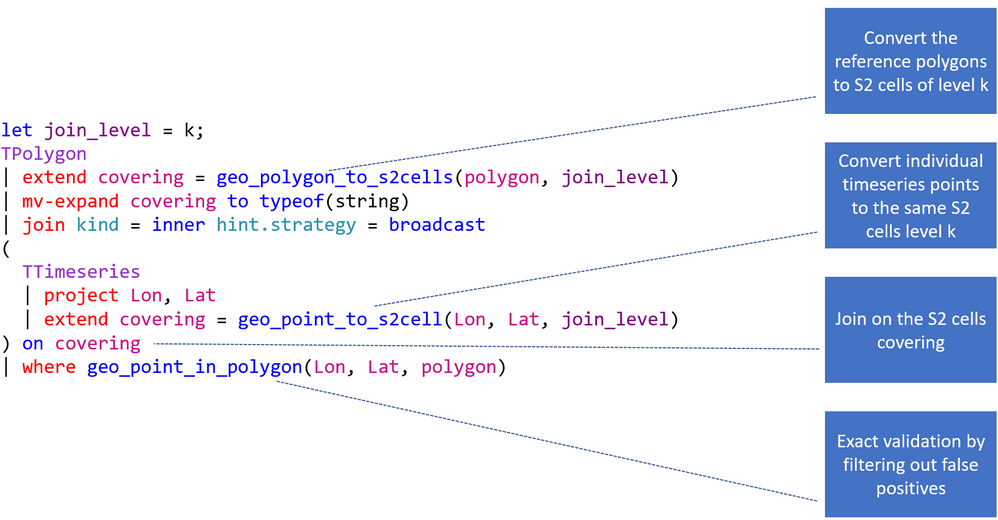
by Scott Muniz | Sep 18, 2020 | Azure, Technology, Uncategorized
This article is contributed. See the original author and article here.
This blog post covers a new geo function and the basics of geospatial joins.
geo_polygon_to_s2cells
geo_polygon_to_s2cells takes a polygon or multipolygon and a S2 cell level as input and creates an array of all token strings which cover it. Be aware that covering a large-area polygon with small-area cells can lead to a huge amount of covering cells. As a result, the query might return null.
KQL-Query:
let polygon = dynamic({"type":"Polygon","coordinates":[[[0,0],[0,50],[100,50],[0,0]]]});
print s2_cell_token_count = array_length(geo_polygon_to_s2cells(polygon, 5));
Result:
Geospatial joins
This query pattern is oftentimes used in various mobility solutions (geospatial telemetry and static reference data), geospatial risk analysis and agriculture optimization using weather data. It is based on the three-dimensional S2 geometry and the functions geo_polygon_to_s2cells and geo_point_in_polygon. By use of this functionality a geospatial join consists of a coarse-grained join using the S2 cell coverage and the exact validation using the geo_point_in_polygon function.
The four main steps:
- Converting polygons to S2 cells of level k,
- Converting points to the same S2 cells level k,
- Joining on S2 cells,
- Filtering by geo_point_in_polygon().
The following picture explains the flow of the entire KQL query. First you need to choose the right S2 cell level. It should not be too big and not too small (it is not recommended to use more than 10.000 cells, 65535 are possible in theory). Second you are creating the S2 cell tokens for the static dataset. Next you are joining the polygons with the timeseries based on the tokens. This provides you with a dataset which might still has some false positives (S2 cell overlap) and that is why you need to end the statement with a check if the actual point is in the polygon.

This is a concrete example of a geospatial join based on the StormEvents and US_States table located on the help cluster. It calculates the damage in $ by state.
KQL-Query:
let join_level = 4;
US_States
| project State = features.properties.NAME, polygon = features.geometry
| extend covering = geo_polygon_to_s2cells(polygon, join_level)
| mv-expand covering to typeof(string)
| join kind = inner hint.strategy = broadcast
(
StormEvents
| project BeginLon, BeginLat , DamageProperty
| extend covering = geo_point_to_s2cell(BeginLon, BeginLat, join_level)
) on covering
| where geo_point_in_polygon(BeginLon, BeginLat, polygon)
| summarize CountOfEvents=count(), DamageInDollar=sum(DamageProperty) by tostring(State)
| top 3 by DamageInDollar desc
Result:
| State |
CountOfEvents |
DamageInDollar |
|
Kansas
|
2298
|
533352500
|
|
Texas
|
3889
|
488525500
|
|
Ohio
|
852
|
371630500
|
by Scott Muniz | Sep 18, 2020 | Azure, Technology, Uncategorized
This article is contributed. See the original author and article here.
Ignite 2020 is next week! Are you excited, because we are! Always great to hear announcements and product developments from the leadership teams, developers and engineers on what we’ve been working on and what’s to come.
Be sure to register! In the meantime here are the other upcoming events and recent posts from the advocate team.
Key Events
Create: Serverless – aka.ms/createserverless
In this 4 hour event, hear from our keynote speakers Chris Coyier and Chris Nwamba on the Serverless landscape in 2020 and the trends you should look out for.
You will also learn:
· How you can unify data with Hasura GraphQL Engine & Azure Functions by Allison Kunz and Burke Holland
· Serverless security 101 by Guy Podjarny and Wassim Chegham
· How to develop low-code Serverless Applications by Linda Nichols and Dona Sarkar
· Overcoming Serverless challenges with Durable Functions by Marc Duiker and Anthony Chu
· Boost your Serverless APIs with API Management by Mike Budzynski and Jeff Hollan
· Serverless Best Practices by Marie Hoeger and Robert Steele
.NET Conf 2020 (dotnetconf.net)
.NET Conf is a free, three day virtual developer event co-organized by the .NET community and Microsoft. This year .NET 5.0 will launch at .NET Conf 2020! Come celebrate and learn about the new release. We’re also celebrating our 10th anniversary and we’re working on a few more surprises. You won’t want to miss this one.
Content Wrap Up
Distributed Tracing With Jaeger and Linkerd
Lucas Santos
In this article, I explain how we can integrate your service mesh using linkerd with distributed tracing using Jaeger
Building Serverless APIs with Azure Functions and Azure SQL
In this article, We discuss about Serverless Computing, Azure Function and Azure SQL in a concise manner. Then. We discuss how to make one using Visual Studio 2019 using C#. In this article, We create an HTTP Trigger Azure Function to Insert a value into our Table in Azure SQL Database every time we make a request to it by passing a name in the query string or the request body. We’ll be using ADO.NET for the database interaction and see how easy it is to make a Serverless Application to perform Insert operations to our database.
Serverless Prediction of a Product Feedback [Community]
If you are developing any product, feedback is much more important. You must trace every feedback like feature request or Bugs/Issues. Open Source projects are much easier to track the feedbacks /bugs, however when coming to any non-open-source projects it is always difficult. In this post, Jayendran explains using the power of serverless how we can grab and maintain every feedback and issues easily in real-time.
Creating a Serverless Resume with Visitor Counter in Azure
What’s a better way to showcase your experience with Azure serverless if not by building your resume/portfolio website using azure serverless services?. I would teach you how to build a resume/portfolio website with a serverless service to store the visitor’s count (Azure Cosmos DB), a serverless service to retrieve and update the visitor’s count from our store(Azure Functions), a serverless service to host our static resume website (Azure Storage) and an additional service to cache and make our static website load faster (Azure CDN).
Crazy Web Performance with Azure Static Web Apps and Azure Functions
Azure Static Web Apps has been a game changer for me in terms of how I build and deploy static web applications. In this post, I talk about why I made the switch to Azure Static Web Apps and also answer some of the common questions I’ve received about the platform!
Serverless with GraphQL
Everything on Azure. Scalable and cost-effective Serverless system leveraging GraphQL API hosted on Azure. Easy deployable and production-ready code with Azure CLI and Azure DevOps. Built a simple API to query your professional details. You can modify and create your own API, isn’t it beautiful.
How to bridge Go AMQP library to Service Bus
Alvaro Videla Godoy
Blog/ What is Bicep? The ARM Template DSL
Justin Yoo
This post discusses how Bicep, the ARM template DSL, looks like and how we can leverage it for ARM template authoring.
How to manage existing Azure Resource Groups using Terraform
Anthony Bartolo
As many organizations look to adopt Infrastructure as Code and DevOps as the new norm, one question that repeatably gets asked is “We have already deployed resources into Azure, how can we manage them in IaC without having to recreate them?”. Say hello to Terraform Import!
Azure Stack Hub Partner Solutions Series – Knowledge Park
Thomas Maurer
Today, I want you to introduce you to Azure Stack Hub Partner Knowledge Park..
The Azure Stack Hub Partner Solutions Series journey continues with a few partners that create a SaaS-like experience for their customers. The knowledgepark, akquinet, and BordonaroIT are working together across different levels of the solution (form the top application, all the way to the platform fabric) to provide SaaS services for over 200 Healthcare environments across the region. See how they are working together to achieve this.
The Curious Developer’s Guide to Portable Azure Functions
Azure Functions allow you to execute small snippets of code, in the cloud, without concern for cloud infrastructure. These functions are triggered by several different types of event sources, making them the building blocks of an event-driven or “serverless” architecture. They’re easy to write, deploy, and connect to other cloud services to create powerful applications. Azure Functions are also open source! But did you know they’re also… portable?
Xamarin Podcast Ep 77: Surface Duo, Android Startup Times, and Xamarin.Essentials
Matt Soucoup
This month James and Matt talk about new Microsoft Learn modules on the Surface Duo. The continuing saga of the Xamarin.Forms Shell quick tips.
Join the Microsoft Azure Hybrid Cloud Webinar Series from Microsoft Indonesia
Thomas Maurer
Together with Microsoft Indonesia, we are offering an Azure Hybrid Cloud Webinar Series with two webinars around Azure Hybrid Cloud. The first one on September 22nd will be called: Innovation Anywhere with Azure Hybrid and on September 23rd: Deep Dive VM and Kubernetes Management to any Infrastructure with Azure Arc
Go Full-Stack for the First Time by Microsoft Technologies
There was a time when Microsoft hated opensource. In the last decade, they realized that opensource is the future and decided to start heavily investing in it. They went from zero to hero. Today, Microsoft has the most opensource contributors and they are the third most active opensource organization. A lot of key elements of the opensource world belong to Microsoft. They have reached the point where you can be a full-stack developer without leaving the Microsoft ecosystem, and I’ll tell you why it is a game-changer.
Top 10 Things to Look Out for When Using Microsoft Teams
Anthony Bartolo
Veronique looks Ten things that happen when performing something specific in Microsoft Teams.
Blog on Messaging Extension using Teams Toolkit
Rabia Williams
Create a get started blog post for new developer who wants to get started on developing Messaging extensions using the Teams Toolkit
Live Coding on Twitch: Developing Node.js + Angular + PostgreSQL Application – Day 09
Glaucia Lemos
Azure Migrate and Availability Zones
Sarah Lean
Explaining the new feature in Azure Migrate where you can migrate your VMs straight into Availability Zones or Sets.
Azure Stack Hub Partner Solutions Series – Knowledge Park
Thomas Maurer
Today, I want you to introduce you to Azure Stack Hub Partner Knowledge Park..
The Azure Stack Hub Partner Solutions Series journey continues with a few partners that create a SaaS-like experience for their customers. The knowledgepark, akquinet, and BordonaroIT are working together across different levels of the solution (form the top application, all the way to the platform fabric) to provide SaaS services for over 200 Healthcare environments across the region. See how they are working together to achieve this.
Taking place in JUG.ru VideoPodcast
Dmitry Soshnikov
A live video podcast organized by creators of DotNext conference.
The Angular Show – State Management pt. 4 – RxJS & Singleton Services
Dan Wahlin
In part 4 of our series on State Management in Angular, panelists Aaron Frost, Brian Love, and Jennifer Wadella spend some time with Deborah Kurtata & Dan Wahlin, two well-known and loved experts on using RxJS for managing the state of your application. Deborah is a Pluralsight author and speaker who has taught many of us the basics of RxJS and how we can effectively use RxJS for state management. Dan is also a Pluralsight author and speaker, as well as the author of the observable-store library that provides a guided approach to state management with RxJS.In this episode, you can expect to learn strategies for using RxJS, observables, subjects, and more, as both data streams and state management solutions for Angular applications. Deborah and Dan share their approaches and what they have learned with the community. Join us as we further unpack state management in Angular using RxJS.
Are you excited about the Surface Duo?
Nitya Narasimhan

by Scott Muniz | Sep 18, 2020 | Azure, Technology, Uncategorized
This article is contributed. See the original author and article here.

Feature Branching and Pull-Request Strategy with Git, GitHub and VSCode
Oscar Garcia is a Principal Software Architect who resides in South Florida. He is a Developer Technologies MVP and certified solutions developer with many years of experience building software solutions. He specializes in building cloud solutions using technologies like AWS, Azure, ASP.NET, NodeJS, AngularJS as well as BI projects for data visualization using tools like Power BI, Tableau and JMP. You can follow Oscar on Twitter @ozkary or his blog at ozkary.com

Load test with Apache JMeter™ against Azure Cosmos DB (SQL API)
Kuniteru Asami is an Azure MVP and core staff member of the Japan Azure User Group. Kuniteru has been providing technical consulting for Microsoft Azure for more than 10 years since its initial release. Moreover, the Japanese Azure expert is the CEO of a company with six Azure MVPs on its staff. Follow him on Twitter @kunyami

How to set attributes of Azure Active Directory application for an app using JavaScript to authenticate users
Tetsuro Takao is an MVP for Developer Technologies who focuses on developing the information system for Windows Store apps and Windows native apps creation. Moreover, Tetsuro providers technical services, such as system engineering, programming, and Lifecycle Management Application. As a community contributor, Tetsuro has been an integral part of the monthly Dotnet lab for more than 10 years. Follow him on Twitter @takaotetsuro and visit his blog.

HOW WE CAN EXTEND MICROSOFT TEAMS WITH CUSTOM APPS — THE NON-TECHNICAL EXPLANATION
Laura Kokkarinen is an Office Development MVP and works as a senior software developer and architect at Sulava in Finland. She has been coding for SharePoint and Office 365 since 2011. Today, her main focus is implementing customizations for Microsoft 365 by utilizing SharePoint Framework, Azure services and the Power Platform. Laura writes a Microsoft 365 and Azure focused blog for other developers at laurakokkarinen.com, and regularly shares her knowledge at international conferences. Follow her on Twitter @LauraKokkarinen.

Running ASP.NET Core app on Azure B1ls VM (penny pinching)
Jiří Činčura is an independent developer focusing on data and business layers, language constructs, parallelism and databases. Specifically Entity Framework, asynchronous and parallel programming, cloud and Azure. He’s a Microsoft MVP and you can read his articles, guides, tips and tricks at www.tabsoverspaces.com. Follow him on Twitter @cincura_net.

by Scott Muniz | Sep 18, 2020 | Azure, Technology, Uncategorized
This article is contributed. See the original author and article here.
It’s the weekend before Microsoft Ignite 2020 and all the Azure services are a buzz! Here is the news the team will be covering this week: Azure Site Recovery update rollup 50, NFS 4.1 support for Azure Files is now in preview, Azure IoT Central August 2020 update, Azure Container Instances – Docker integration now in Docker Desktop stable release and of course our Microsoft Learn module of the week.
Azure Site Recovery update rollup 50 – September 2020
The latest Azure Site Recovery update provides fixes, updated Linux support for the Mobility service, and download links for Site Recovery components. The latest versions of these Azure Site Recovery components include:
- Site Recovery Unified Setup and Site Recovery Mobility Agent (both are version 9.37.5724.1)—Used for Azure Virtual Machine (VM) replication as well as replication of on-premises VMware virtual machines and physical servers to Azure.
- Site Recovery configuration server Open Virtualization Format (OVF) template (version 5.1.6347.0)—Used for replication of on-premises VMware virtual machines and physical servers to Azure.
- Site Recovery Provider (version 5.1.6347.0)—Used for replication of Hyper-V virtual machines to Azure.
- Recovery Services Agent (version 2.0.9192.0)—Used for replication of Hyper-V virtual machines to Azure.
NFS 4.1 support for Azure Files is now in preview
Azure Files now adds support for NFS v4.1 file system protocol for an easy migration of your Linux-centric workloads. Any application ever written for Linux file systems can run on NFS. Here is a subset of customer use cases we have seen during the preview:
- Linux application – Shared storage for applications like SAP, storage for images or videos, Internet of Things (IoT) signals, etc.
- End user storage – Shared file storage for end user home directories and home directories for applications like Jupyter Notebooks. For lift-and-shift datacenter NAS data to cloud to reduce the on-premises footprint and expand to more geo regions with agility.
- Container-based applications – Persistent storage for Docker and Kubernetes environments. Microsoft is also launching the preview of CSI driver for Azure files Support for NFS today.
- Databases – Hosting Oracle database and taking its backups using Recover Manager (RMAN). Azure Files premium tier is highly optimized for database workloads.
Azure IoT Central new and updated features—August 2020
A plethora of updates and features are being made available which are included in the August 2020 update. The new features and updates include:
- Job Improvements: Jobs creation has been redesigned with a new wizard experience you can use to create, run, and save a job. You can now navigate easily between the last 30 days of job runs and saved jobs.
- File upload support added: Upload media and files from your devices to the cloud. Files are stored in an Azure storage endpoint.
- New data export capabilities (preview): Send filtered and enriched data from devices in near real time to your cloud destinations to unlock business insights with IoT data.
- CLI improvements: To expand the capabilities of the CLI, we’ve re-organized the commands in the azure-iot extension. New commands include az iot central user, az iot central api-token, and az iot central device compute-device-key to generate a device SAS key for provisioning.
- Reduced application provisioning time: Provisioning a new IoT Central application now takes seconds instead of minutes, letting you get started within seconds of creating an application. This also streamlines creating IoT Central applications programmatically. The improvement is a result of optimized architecture and integration with the Device Provisioning Service (a core Azure IoT component).
Azure Container Instances – Docker integration now in Docker Desktop stable release
The Azure Docker integration enables you to deploy serverless containers to Azure Container Instances (ACI) using the same Docker Command-line (CLI) commands from local development. Use docker run to spin up a single-container or docker compose up to deploy multi-container applications defined with a Docker Compose file. You can also view logs, attach a shell, and perform other actions against the containers running in ACI, just as if those containers were running locally. In addition, you can now use Compose to attach Azure File Share volume mounts to your containers in either a local or ACI context.
MS Learn Module of the Week

Introduction to Docker containers
This MS Learn module provides an introduction of the benefits of using Docker containers as a containerization platform. It will also cover how to evaluate whether Docker is an appropriate containerization platform for you and detail how the components of Docker containers support compute container implementations.
Let us know in the comments below if there are any news items you would like to see covered in next week show. Az Update streams live every Friday so be sure to catch the next episode and join us in the live chat.
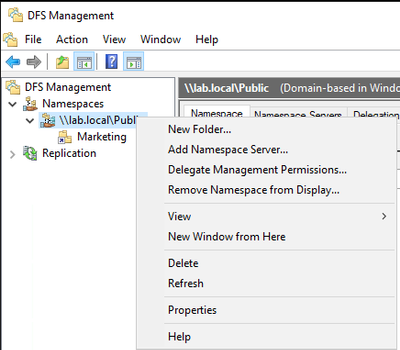
by Scott Muniz | Sep 18, 2020 | Azure, Technology, Uncategorized
This article is contributed. See the original author and article here.
Introduction
Hello everyone, this is Andrew Coughlin and I am a Customer Engineer at Microsoft focusing on Azure IaaS. In this blog I will focus on a couple of questions I get quite often around Azure File Sync, does Azure File Sync support DFS-N, how do you set DFS-N with Azure File Sync and can I have two Azure File Sync servers in a DFS-N target folder.
Azure File Sync is a service that allows you to turn your on-premises servers into caching servers. All files in the directory you specify for Azure File Sync will be copied to a file share in a storage account. You can also enable a feature called Cloud Tiering, with this feature you can set which files stay on premises and which ones are in the cloud only. To the end user this feature is seamless, and they don’t know if their file is on the file server or in the cloud. For more information about Azure File Sync head over to the planning for an Azure File Sync deployment page.
Prerequisites
- Share the folders out on each server(s)
- Create DFS Namespace as documented here.
Does Azure File Sync Support DFS-N
One of the most common questions I receive is can you use Azure File Sync with Distributed File System Namespaces (DFS-N). A lot of corporate customers use DFS-N to hide the backend file server. This allows them to change the backend server without having impact to their end users. Azure File Sync does support DFS-N, from an interoperability it also supports Distributed File System Replication (DFS-R) for those customers looking to migrate away from DFS-R to Azure File Sync. Let’s see how we can add a share on an Azure File Sync server to DFS-N.
Add Share under Azure File Sync to DFS-N
First, we will want to launch the DFS Management tool and connect to the name space if the name space doesn’t show up. Then we will right click on the name space and click “New Folder”.

Next you will provide the folder name and click Add.
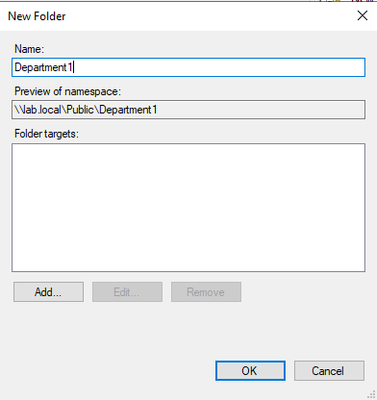
Then click Browse, type the Azure File Sync server, if needed, and select the folder and click OK.
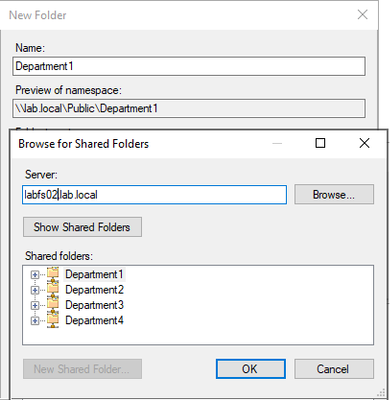
Click OK, on the Add Folder Target window.

Click on OK, on the New Folder window.
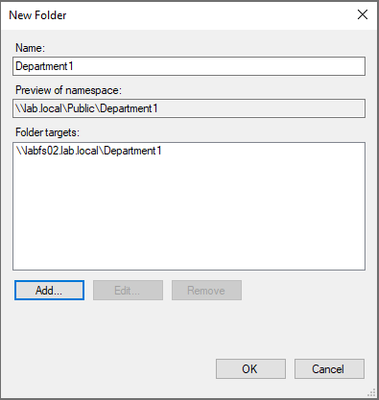
Add Additional / New Azure File Sync Server to a Folder Target
There are a couple of reasons why you might want to add a second server to a folder target that has a share syncing with Azure File Sync:
- Two servers in different locations part of the same sync group
- DR purposes
- Retiring an older Azure File Sync server
NOTE: At the time of writing this article global locking is not supported for Azure File Sync or Azure Files.
To add an additional server to a target folder in DFS-N with Azure File Sync. First open DFS Management, find the folder you are wanting to add to the target folder and right click it and go to Add Folder Target.
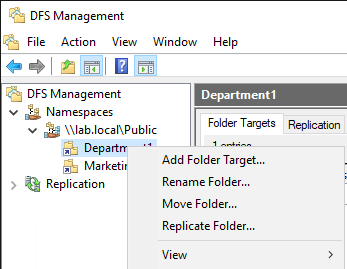
Click Browse, Type the second file server, and click Show Shared Folders. You will then select the shared folder and Click OK.
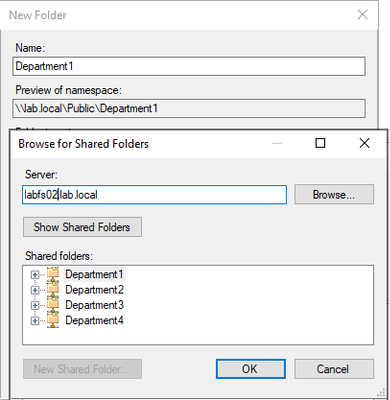
Click OK, on New Folder Target window.

You will receive a replication message. This message is asking you if you want to setup a replication group. With two servers’ part of the same sync group we are using Azure File Sync to keep both servers synchronized. You will click No because of this.
NOTE: DFS-R and Azure File Sync can co-exist, the use case for this is for migrating from DFS-R to Azure Files, for more information about this migration process please see this link.
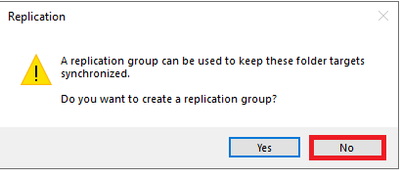
Conclusion
In this blog I covered supportability with Azure File Sync with DFS-N, how to add a server with Azure File Sync to DFS-N and how to add an additional server to a target folder in a DFS Namespace. Thank you for taking the time to read this blog, I hope this helps you and see you next time.






Recent Comments